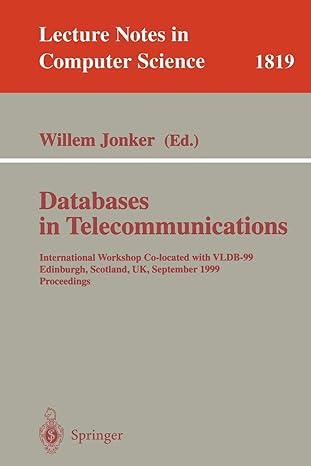Answered step by step
Verified Expert Solution
Question
1 Approved Answer
Implement a queue data type. Then use it to simulate the evolution of waiting queues, by invoking several instances of the queue data type. To
Implement a queue data type. Then use it to simulate the evolution of waiting queues, by invoking several instances of the queue data type.
To fix your ideas, assume that we are simulating a check-in operation for an airline company at an airport terminal.
- We have two classes of service: first class and coach. Each class of service has a dedicated queue.
- There are two service stations for first class and three for coach.
- Each service station takes passengers from the corresponding queue; but if a first class service station is free and the queue for coach is not empty then the service station serves passengers from the coach queue.
- Passenger arrival times are random, but subject to average arrival times; for example, we get a first class passenger every five minutes and a coach passenger every two minutes on average. Actual arrival times are random.
- Passenger service times are also random, but subject to average service times; for example, first class passengers usually require six minutes of service and coach passengers get on average 2 minutes of service. These are average times; actual times vary. All times are measured in minutes.
- The simulation starts with empty waiting queues and free service stations. At some point in time (usually 40 minutes prior to departure time) the company closes the queues (no more passengers are admitted); then the simulation ends when all the queues are empty and all the service stations are free.
Inputs to the simulation:
- The duration of the check in (make it arbitrarily long, do not worry about it being or not being realistic).
- The coach average arrival rate, and average service rate.
- The first class average arrival rate and average service rate.
Outputs of the Simulation:
- The duration of the simulation (which may be longer than the input parameter, as when checkin closes, there may be passengers in the waiting queues and service stations).
- The maximum length of the queue for each queue.
- The average and maximum waiting time for each queue.
- The rate of occupancy of each service station (percentage of time each station was busy).
- If you want: show the real-time evolution of the queues during the run-time simulation.
Step by Step Solution
There are 3 Steps involved in it
Step: 1

Get Instant Access to Expert-Tailored Solutions
See step-by-step solutions with expert insights and AI powered tools for academic success
Step: 2

Step: 3

Ace Your Homework with AI
Get the answers you need in no time with our AI-driven, step-by-step assistance
Get Started


